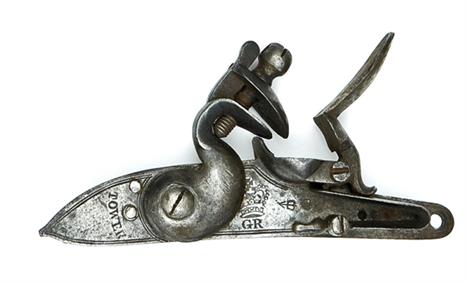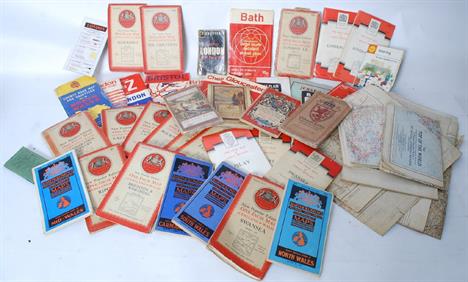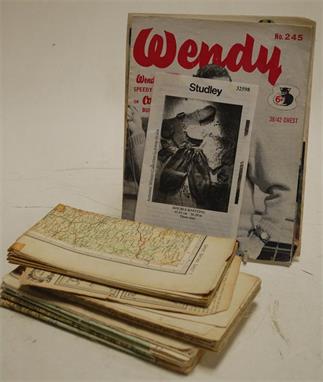GOOD SELECTION OF MEDAL RIBBONS & MEDAL BROOCHES, small selection of CLOTH BADGES including The Cheshire Regiment gilt and silver bullion star, dog tags, a selection of APPROXIMATELY SEVENTY MAINLY BRASS MILITARY BUTTONS together with an ORDNANCE SURVEY FOLDED MAP `France and Part of Belgium` dated 1918 and TWO OTHER FOLDED MAPS
We found 12130 price guide item(s) matching your search
There are 12130 lots that match your search criteria. Subscribe now to get instant access to the full price guide service.
Click here to subscribe- List
- Grid
-
12130 item(s)/page
20th Century: Collection of British and Irish military badges A large mixed collection cap badges, collar badges, shoulder titles, buttons and others including Connaught Rangers Leinster Regiment, Royal Inniskilling Fusiliers, Royal Irish Rifles, Royal Irish Fusiliers etc. Irish Army examples including 11th Motor Squadron, 2nd Eastern Brigade and Defence Forces Training Centre wool shoulder flashes. Also with 8 Royal Army Service Corps and Royal Army Ordnance Corps matchbox covers and a Royal Air Force Station Heliopolis 1931-32 silver football medal.
20th Century: Collection of assorted British Army badges A mixed collection of British Army badges including Royal Engineers, Royal Artillery, Royal Army Ordnance Corps, East Surrery Regiment, Lincolnshire Regiment, Royal Marines etc. Also with some other badges and medals including Empire Day medal, Royal Ulster Constabulary badge etc. (24 items)
TEN ORDNANCE SURVEY 1:50,000 FIRST SERIES SHEET MAPS comprising sheets 181 (Minehead & Brendon Hills); 182 (Weston-super-Mare & Bridgwater); 183 (Yeovil & Frome); 184 (Salisbury & The Plain); 185 (Winchester & Basingstoke); 192 (Exeter & Sidmouth); 193 (Taunton & Lyme Regis); 194 (Dorchester & Weymouth); and 195 (Bournemouth & Purbeck).
A weather station, by L Casella, Maker to The Admiralty and Ordnance, London, housed in a glazed and ebonised case containing a single fusee timepiece with a 7in silvered dial with subsidiary seconds dial, and a weighted adjustable pendulum, a barograph turntable and a barometer with a 7in silvered dial engraved 'L Casella...', case 60cm high CONDITION REPORT: Barograph drum missing. Hand to barometer missing. Hands to clock bent. It is not known whether any movements work. Some wear.
MAP, KENT. – Edward STANFORD (publisher). Ordnance Survey [of the County of Kent.] London: [n.d. but circa 1865.] Hand-coloured engraved folding map on 2 sheets (each 1310 x 965mm.) each in 42 sections and backed onto linen. (Light browning.) Folding within a contemporary cloth case (defective).
6 Lima ‘OO’ gauge diesel locomotives. Class 31 RN 31116, ‘Rail Celebrity’ in Infrastructure livery. Class 37 RN 37684, ‘Peak National Park’ in two-tone grey livery. Class 47s RN 47972 ‘The Royal Army Ordnance Corps’ in BR Technical grey & red livery and RN 47803 (unnamed) in Infrastructure yellow & grey. RN 47323 ‘The Rover Group’ in Railfreight Distribution two-tone grey. Plus a class 67 RN 67005 ‘Queen’s Messenger’ in EWS livery. All boxed, minor/some wear, certificates & leaflets included. Contents Mint.
Philips' Atlas of the Counties of England, 1876. Folio, qtr. binding, gilt titling, marbled eps., aeg. Reduced from the Ordnance Survey by Edward Weller. New Edition with complete consulting index by John Bartholomew. CONDITION REPORT: Some moderate wear to the extremities of the binding but still very sound. Some very slight sporadic foxing o/w a vg copy.
Collection of mainly early 20th.C Ordnance Survey maps, differing scales, many linen backed, including : Montrose, Sheet 20, 1908; Anglesey, Sheet 41, 1922; Midlands, 1920, Sheet 5; Isles of Scilly 1933; Truro and St.Austell, 1934, sheet 143, and Lyme Regis, 1910, Sheet 142. A total of 25 maps. CONDITION REPORT: One or two with loss of at least one cover, some fold-wear and repairs on others. Generally a well preserved collection.
An 18th century coloured map of Gloucestershire dated 1712, 36 x 43 cm in moulded gilt frame together with a facsimile of the 1900 second edition Ordnance Survey map of Tetbury, 42 x 60 cm in bronze coloured frame, a coloured 19th century hunting engraving and a black and white photograph of the hunt
A Third Reich Army Ordnance issue sabel, by Alexander Coppel, Solingen, blade 31½” with Waffenamt stamp on back edge, the brass hilt with Waffenamt stamp on all parts, the underside of the crosspiece stamped “6337” and “AC/G”, in its black painted scabbard with matching marks. GC (leather fingerschlauf missing)
7 cap badges: Bloomsbury Rifles, Middlesex Vol Regt, Q Mary’s AAC, Sudan Defence Force with stud, and companion collar, Sudan Ordnance Corps with brooch pin, small Rough Riders sidecap and London Scottish thistle; 25 enamelled lapel badges, including Home Protection Brigade, Sussex (2), Coronation 1902, Railway Service LMS and LNER (2), RN Division sweetheart marked “sterling”, Ex Services India, etc; a silver Territorial Army Rifle Asso. medallion HM 1930; sundry other items. Generally GC
** A RARE .600 CALIBRE QUEEN ANNE FLINTLOCK REGULATION PISTOL, THE LOCK BY I. PEDDELL, CIRCA 1702-14 with two-stage barrel stamped with Ordnance and Tower proof marks, signed lock retained by three side nails, numbered `7` on the tail, with `AR` crowned and crowned broad arrow mark, the inside stamped `ED` and with a fleur-de-lys mark, full stock carved with an apron moulding about the tang (small repairs), brass mounts comprising solid side-plate, trigger-guard with rounded finial, butt-cap with `AR` `P`, `14` and broad arrow accompanied by engraved linear borders, ramrod-pipe and brass-tipped ramrod 35.5 cm; 14 in barrel James Peddell is recorded 1688-1716 as a maker of complete arms including a government gift to New York in 1702 and 1710. See lot 224.
** A RARE .650 CALIBRE 1730 PATTERN LAND SERVICE PISTOL WITH 1729 PATTERN LOCK, DATED 1729 with tapering barrel stamped with Ordnance and Tower proof marks, regulation dated lock with `GR` crowned, broad arrow and `Tower` (the cock repaired), stamped `WI` and `30` crowned on the inside, regulation full stock carved with a moulding about the tang (small cracks and chips), regulation brass mounts, and brass-tipped ramrod 30.5 cm; 12 in barrel See De Witt Bailey 1997, pp. 18-19.
** AN EXCEPTIONALLY RARE .650 CALIBRE JAMES II FLINTLOCK COMBINED GRENADE LAUNCHER AND MUSKET BY JAMES PEDDELL, LONDON, CIRCA 1687 with sighted barrel formed in four stages and with a moulded muzzle ring, retained by a slender steel band muzzle band, octagonal then polygonal breech stamped with Ordnance marks, long rectangular tang, slightly curved signed lock engraved with border ornament and `I2R` crowned, fitted with rounded pan incorporating a rear gate and a slender trap-cover on the tail for grenade ignition, engraved cock, walnut full stock, the butt formed of a bottle-shaped steel extension forming the grenade launching base, stamped with `IR` crowned on the neck, separated from the tang by a brass washer, the rear of walnut stamped `234` and with a further mark on the right (one small crack), fitted with a hinge and retained by a sprung button catch on the top (cracked on one side), the fore-end with a stirrup mount and a full length iron bar for mounting, iron trigger-guard, brass mounts comprising scrolling side-pate, butt-cap with tang of shaped outline, three moulded ramrod-pipes and slender fore-end cap (ramrod missing) 98 cm; 38 5/8 in barrel Provenance Clay P. Bedford Exhibited Early Firearms of Great Britain and Ireland, the Metropolitan Museum of Art, New York, 1971 Literature Herbert A. Sherlock, Early Grenade Launchers of Great Britain, in, Military Collector and Historian, June 1951, pp. 44-6. Early Firearms of Great Britain and Ireland, the Metropolitan Museum of Art, New York, 1971, cat. No. 105. The present combined grenade thrower and flintlock musket is one of three known examples, the other two being preserved in the Royal Armouries, Leeds (Inv. Nos. XII 260 and 261), by James Peddell and Hartwell respectively. John Tinker invented this combined musket and grenade thrower in 1681 and was awarded a pension of five pounds per quarter for it. The Ordnance Records include a minute referring to three gunmakers, Collins Groome, John Hartwell and James Peddell, for stocking and locking brass hand mortar pieces made by the Ordnance brass founder William Wightman at Moorfields. James (1) Peddell apprenticed to John Silke, became free of the Gunmaker`s Company, 1682; was elected assistant, 1699; and became Master 1703-4. He was Gunmaker to Ordnance, 1685-1717; The East India Company, 1716; The Hudson Bay Company 1687-1722 and the Royal African Company from 1721 until his death in 1723. See H. L. Blackmore 1961, pp. 35-36, for a detached grenade launcher see F. Grose 1801, vol. II, p. 363.
** A .950 CALIBRE 1737 PATTERN FLINTLOCK RAMPART GUN, DATED 1744 with sighted barrel stamped with Ordnance proof marks, , grooved tang, border-engraved dated lock signed `Jordan`, with `GR` crowned and broad arrow mark, regulation full stock (light worm), stamped with inspector`s marks on the butt, regulation brass mounts, iron stirrup mount, and iron ramrod 137 cm; 54 in barrel
** A .750 CALIBRE 1779 PATTERN SHORT LAND PATTERN FLINTLOCK MUSKET the barrel struck with Ordnance and Tower proof marks and traces of a regimental inscription (pitted, bore worn at the muzzle), border-engraved lock with `GR` crowned, `Tower` and broad arrow, regulation full stock (cracked through and repaired ahead of the rear ramrod-pipe), brass mounts including escutcheon engraved `A/12`, and steel ramrod 106.7 cm; 42 in barrel
** A .650 CALIBRE FLINTLOCK MUSKET BY GRICE, DATED 1759 with sighted barrel stamped with Ordnance and Tower proof marks, border-engraved signed and dated lock with broad arrow mark, regulation stock, regulation brass mounts including four ramrod-pipes, a pair of sling swivels, and steel ramrod 106.6 cm; 42 in barrel
** A FLINTLOCK TURNPIKE GUN, EARLY 18TH CENTURY, THE BARREL SIGNED JOHN SMART with brass barrel formed in two stages, swelling towards the muzzle and with a raised band behind, inscribed `John Smart att Londine Fecit 1710` (later), struck with London proof marks and the barrelsmith`s mark of Thomas (1) Hawley, incorporating a raised belt cut for the back-sight, iron tang, flat lock retained by three screws, stamped with the letters `M` above `RX` in a trefoil on the inside, full stock (areas of worm) carved about the ramrod aperture, iron trigger-guard, a single brass ramrod-pipe, and later ramrod 72 cm; 28 3/8 in barrel John Smart was made Free of the Gunmaker`s Compnay by patrimony in 1705, presented his proof piece 1707 and is recorded as gunmaker `against Norfolk Street in the Strand` circa 1715. Thomas (1) Hawley is recorded as gunmaker to Ordnance, circa 1682-1707.
A RARE .650 CALIBRE QUEEN ANNE FLINTLOCK REGULATION PISTOL, THE LOCK BY I. SIBLEY, CIRCA 1702-14 with tapering barrel stamped with marks at the breech (pitted), associated contemporary signed lock retained by two side nails, numbered `7` on the tail, with `AR` crowned and crowned broad arrow mark, full stock carved with an apron moulding about the tang (chipped about the tang and the rear of the lock, fore-end cracked), brass mounts comprising solid side-plate, trigger-guard with rounded finial, border-engraved butt-cap with `AR`, ramrod-pipe (loose) and associated steel ramrod 30.5 cm; 12 in barrel John Sibley is recorded as supplier of complete arms to Ordnance circa 1688-1711.
A COMPOSITE .600 CALIBRE FLINTLOCK REGULATION PISTOL, EARLY 19TH CENTURY with tapering barrel struck with Ordnance marks at the breech, border-engraved lock with crown and `Tower` (one side nail missing), full stock (areas of wear), and regulation brass mounts (later steel belt hook), and associated horn-tipped ramrod 31 cm; 12 1/4 in barrel
-
12130 item(s)/page


















![MAP, KENT. – Edward STANFORD (publisher). Ordnance Survey [of the County of Kent.] London: [n.d. but circa 1865.] Hand-](http://lot-images.atgmedia.com/SR/10123/2902926/3009-2014219153837_468x382.jpg)
![MAP, HAMPSHIRE. – [?ORDNANCE SURVEY (publishers). Map of the County of Hampshire. N.p.: n.d. but circa 1870.] Lithograp](http://lot-images.atgmedia.com/SR/10123/2902926/3022-201421915394_468x382.jpg)





























